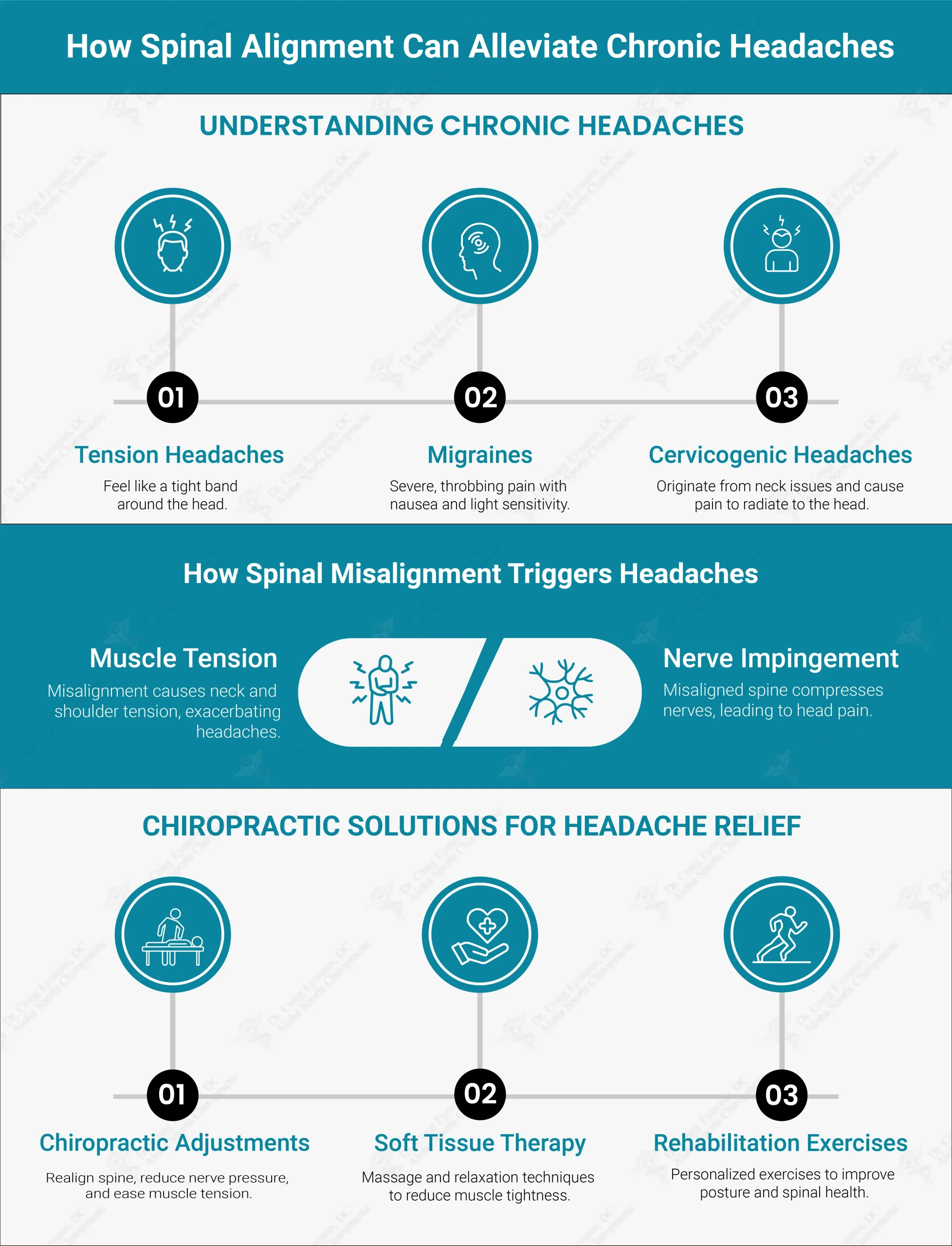Chronic headaches are a pervasive health issue affecting millions worldwide. Persistent, recurring headaches can substantially impact your way of existence, work efficiency, and general well-being.
Spinal misalignment is often overlooked in traditional headache treatments. However, it plays a significant part in numerous instances of chronic headaches. Addressing the relationship between vertebral wellness and migraines is critical for successful treatment and lasting relief.
With more than 25 years of experience as a chiropractor, I know how important it is to take care of your spine if you get headaches frequently.
In this in-depth guide, we’ll look at the connection between spine misalignment and chronic headache pain, giving people who suffer from this crippling condition information that could change their lives.
Understanding Chronic Headaches
Chronic headaches are more than just an occasional nuisance. They’re a complex medical condition that can stem from various causes, including spinal misalignment. Stress (Sympathetic Dominance) plays a significant role in chronic headaches. It increases tension and muscle metabolism, increasing metabolic waste, including lactic acid. This buildup can contribute to headache pain. Let’s delve into the types of chronic headaches and how they are diagnosed.
Types of Chronic Headaches
- Tension Headaches: Tension Headaches are the most prevalent form of headache pain. Those who wear them frequently feel as though they have a constricting ring around their heads.
- Migraines: People with these severe, throbbing headaches often feel sick, are sensitive to light and sound, and have trouble seeing.
- Cervicogenic Headaches: These headaches come from the neck and are caused by problems in the cervical spine.
Symptoms and Diagnosis
- A continuous tightness or pressure around the head distinguishes tension-producing headaches.
- Migraine patients typically feel pounding pain on the opposite side of their head.
- People who get cervicogenic headaches feel pain in their neck that spreads to their head. They may also have trouble moving their neck.
The Anatomy of the Spine
To understand how spinal misalignment affects headaches, it’s crucial to have a basic grasp of spinal anatomy. The spine not only supports the body and allows movement but also houses our central nervous system, consisting of an incredible 72,000 miles of nerves. This vast network is crucial for understanding how spinal misalignment can lead to chronic headaches.
Anatomy of the Spine
- The cervical region (neck)
- Thoracic vertebrae (upper and middle back).
- Pelvic spine (lower back).
Function of the Spine
- Sustaining the human body’s load.
- Preserving the vertebral column.
- Assisting mobility.

Mechanisms Linking Spinal Misalignment to Headaches
Understanding how spinal misalignment contributes to headaches is critical to effective treatment.
How Misalignment Affects Nerves
Spinal misalignment can lead to nerve impingement, where nerves are compressed or irritated. It can affect the cervical plexus and even the brainstem, leading to referred pain in the head. It’s important to note that when vertebrae don’t function properly due to subluxation, it can lead to wear and tear on the discs, ligaments, muscles, and other spinal tissues.
This nerve interference can cause the body to function at a reduced rate, potentially leading to pain, inflammation, and tenderness. This explanation of how vertebral subluxations cause spinal degeneration is crucial, as it’s often overlooked in traditional medical fields outside of chiropractic care.
Many people are surprised to find out that their spine has degenerated, and traditional medical doctors often dismiss it as normal wear and tear with no solution.
However, as a chiropractor, I understand the underlying causes of spinal degeneration and can offer interventions to stop and potentially reverse this process. Chiropractic care takes a preventative approach to preserving spinal wellness and preventing further degeneration.
Cervicogenic Headaches
Issues in the cervical spine directly cause these headaches. Common causes include:
The Role of Muscle Tension
Spinal misalignment frequently causes discomfort and anxiety, especially in the areas of the neck and shoulders. This tension can trigger or exacerbate headache symptoms.
Diagnosis of Spinal Misalignment
Accurately diagnosing spinal misalignment is crucial for effective headache management.
Clinical Evaluation
- Spinal alignment
- Range of motion
- Muscle tension and tenderness
- Subluxation
Imaging Techniques
- X-rays to visualize bone structure and alignment
- MRI or CT scans for an in-depth examination of soft tissues, possible nerve compression, and compression of the spinal cord. These imaging techniques also provide a clear view of your spinal degeneration status. It’s important to note that while some spinal degeneration is a normal part of aging, excessive degeneration can be prevented and managed.
Differential Diagnosis
It’s important to distinguish between different types of headaches and their causes. It often involves ruling out other conditions and identifying the specific role of spinal misalignment in each case.
Related, Understanding Spinal Manipulation and How It Help Relieve Pain
Chiropractic Management of Spinal Misalignment and Chronic Headaches
In 25 years as a chiropractor, I’ve developed a comprehensive approach to managing spinal misalignment and chronic headaches. I endorse healing every individual rather than merely alleviating symptoms.
This comprehensive approach has worked well for a lot of my clients. It treats the underlying causes of spine-related headaches. My treatment plans are always unique and made to fit each person’s wants and conditions.
Chiropractic Adjustments
Chiropractic adjustments are the key element of my treatment approach. I employ various methods to straighten the spine and reduce strain on the muscle and nerve systems. One of my preferred techniques is high-velocity, low-amplitude (HVLA) modifications. These quick, precise movements can effectively restore proper alignment.
I often use the Activator technique for patients who prefer a gentler approach. It involves a small, hand-held device that delivers targeted, low-force impulses. Both treatments are intended to alleviate nerve discomfort and muscular tightness. These adjustments can significantly alleviate headache symptoms for many patients.
Related, The Science Behind Chiropractic Adjustments and Its Effectiveness
Soft Tissue Therapy
Alongside spinal adjustments, I frequently incorporate soft tissue therapies into my treatment plans. Massage treatment and relaxation procedures are beneficial. These methods help relax tense muscles around the spine and neck, improve blood flow to affected areas, and promote healing.
Soft tissue work also helps reduce inflammation, which is often a contributing factor to chronic headaches. I’ve found that combining these therapies with adjustments enhances overall treatment effectiveness. Many of my patients report faster relief and longer-lasting results with this combined approach.
Rehabilitation Exercises
Exercise is a crucial component of my treatment plans. I always prescribe customized exercise programs for my patients. These programs focus on improving posture, strengthening supporting muscles, and enhancing spinal flexibility. Correct posture is essential for maintaining spine homeostasis.
Powerful supportive musculature helps to avoid further imbalances. Flexibility exercises keep the spine and surrounding tissues supple. I walk individuals through these movements, making sure they do them appropriately.
Regular practice of these exercises helps maintain the benefits of chiropractic adjustments. They also help to avoid repeated episodes of neurological conditions and migraines.
Modalities and Adjunctive Therapies
I often incorporate additional therapies to complement chiropractic adjustments and exercises. Electrical stimulation is one such therapy.
It helps reduce pain and muscle spasms around the spine and neck. I also employ cranial adjusting strategies to treat difficulties with the craniosacral system. This gentle technique can help alleviate headaches, jaw pain, and other symptoms associated with cranial misalignments.
For some patients, I recommend acupuncture as a complementary treatment. It can provide additional pain relief and help balance the body’s energy. These adjunctive therapies enhance the overall treatment plan. They treat many areas needing treatment and recovery, aiding the human body’s healing mechanisms.
Lifestyle and Nutritional Counseling
I strongly believe in addressing lifestyle factors contributing to spinal health and headaches. Dietary guidance is an essential component of this. I provide nutritional advice to help minimize irritation in the body’s tissues. This frequently entails boosting anti-inflammatory foods and minimizing processed meals.
I also concentrate on stress-management approaches. Long-term stress can cause muscle tightness and worsen migraines. I teach my patients various relaxation methods and stress-reduction strategies. These lifestyle changes support the physical treatments and promote overall well-being.
Collaborative Care Approaches
In my profession, I frequently work with other medical professionals to guarantee complete treatment. This collaborative method enables a more comprehensive therapy approach. I work with general care doctors to meet all patients’ health needs. When needed, I recommend clients to professionals for further assistance.
It might include neurologists for complex headache cases or orthopedic specialists for severe spinal issues. Together, we develop interdisciplinary treatment plans. This teamwork ensures that all of the patient’s health needs are met, leading to more effective and well-rounded care for chronic headaches and spinal misalignment.
Get Your Spinal Misalignment Treated at Aloha
The connection between spinal misalignment and chronic headaches is clear and significant. Addressing spinal health often relieves persistent headache pain and improves overall quality of life.
I recommend that everyone with persistent headaches include chiropractic adjustments in their treatment plan. Contact my office to discuss how fixing your misaligned spine could help you eliminate your headaches and regain health.
REFERENCES
- Robbins, M. S., & Lipton, R. B. (2020). Chronic headaches. In StatPearls. StatPearls Publishing. https://www.ncbi.nlm.nih.gov/books/NBK559083/
- ScienceDirect. (n.d.). Compression injury of nerves. Retrieved August 6, 2024, from https://www.sciencedirect.com/topics/medicine-and-dentistry/compression-injury-of-nerve.
- Bendtsen, L., & Evers, S. (2003). Cervicogenic headache after whiplash injury. The Clinical Journal of Pain, 19(6), 354-360. https://pubmed.ncbi.nlm.nih.gov/12946292/
- DISC Spine Institute. (n.d.). Cervical discs may cause headaches. DISC Spine Institute. https://www.discspine.com/back-stories/is-cervical-degenerative-disc-disease-causing-your-headache/[1]
- Sydney West Physiotherapy. (n.d.). Why poor posture can give you headaches. Sydney West Physiotherapy. https://sydneywestphysio.com.au/physiotherapy/why-poor-posture-can-give-you-headaches/
- Rezaeian, T., Mosallanezhad, Z., Nourbakhsh, M. R., Ahmadi, M., & Nourozi, M. (2020). The impact of soft tissue techniques in the management of migraine headache: A randomized controlled trial. Journal of Bodywork and Movement Therapies, 24(3), 41-47. https://doi.org/10.1016/j.jbmt.2020.01.008

Meet Dr. Craig Eymann, a dedicated chiropractor and yoga enthusiast with over two decades of expertise in spinal health, sports chiropractic, and personalized care, prioritizing misalignment correction for swift injury resolution.



Leave A Comment